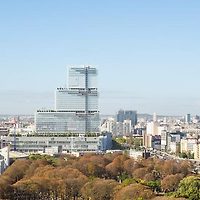
The Residence Palace was built between 1922 and 1927 at the initiative of the financier Lucien Kasin and designed by the Swiss architect Michel Polak. The complex is a collective housing experiment under the form of luxurious service flats located next to the city centre. The project will only have a short commercial success and after World War II, the art deco building is converted into ministerial offices by the Belgian State. An extension with a new facade was built in the years ’60, behind the original building in front of the rue de la Loi - Wetstraat. Later in the years ’80, the Eastern wing is demolished in order to erect the Justus Lipsius building, current seat of the Council.

The original facades, as well as the entrance halls and the corridors on the ground floor are today listed as part of the Belgian cultural heritage. According to urban planning regulations, the building is extended on the North- East side by two new facades to transform its current “L” shape into a “cube”. This outer area is converted into a glass atrium protecting from the urban dust. It covers the principal entrance as well as a new lantern-shaped volume incorporating the conference rooms.

The shape of this volume follows the minimal required surface for each type of room, as for example the press room (level +1), the smallest 50-persons dining room (level +11), the largest meeting room enabling 250 persons meetings (level +5), other meeting rooms (level +3, +7) and finally the largest dining room for official diners (level +9). Each level of this volume has an elliptic plan with different dimensions but the same centre and the same principal axis. The structure of this object is rigorously symmetrical although it does not appear so.

The new double facade, made of a harmonized patchwork of re used old oak windows with simple crystal like single glazing (from the different European countries) provides the necessary acoustic barrier from the traffic noise of the Rue de la Loi - Wetstraat and it also offers a first thermal insulation for the inner space. Indeed, following to UE recommendations about energy savings, many old buildings across Europe will change their window frames for double glazing in the next few years. In the context of a sustainable development approach, it is decided to restore some of those millions of old though still efficient window frames, and re-use them in this project.

This new façade will be both a practical and philosophical statement about the re-use of these traditional constructions elements, expressing the European diversity of cultures. Moreover, the council wishes this building to be from all points of view an example as far as sustainable development is concerned. This wish is displayed in many aspects of the architectural and technical design. As an example, an umbrella of photovoltaic panels for the electricity production covers both the new and the historical parts, which symbolizes also the link between the present, the past and the future.

유럽 의회와 유럽연합 의회
레지던스 팰리스는 1922년과 1927년 사이에 금융가 루시앙 카신(Lucien Kasin)의 주도 하에 지어졌으며 스위스 건축가 미셸 폴락(Michel Polak)이 설계를 맡았다. 이 복합단지는 도심 옆에 위치한 고급 서비스 아파트 형태의 집단 주택 실험이다. 이 프로젝트는 짧은 상업적 성공을 거두게 되며, 2차 세계대전 이후, 예술적인 아르데코 건물은 벨기에 정부에 의해 각료 사무실로 전환되었다. 새로운 정면을 가진 증축부는 60년대에 라 로이- 웨츠트라트(rue de la Loi - Wetstraat) 앞에 있는 원래 건물 뒤에 지어졌다.

80년대 후반에 현재 의회의 의석인 유스튀스 립시우스(Justus Lipsius) 건물을 세우기 위해 동쪽 날개부를 철거하게 된다. 1층에 있는 원래 건물의 정면과 현관, 홀, 복도는 벨기에 문화 유산의 일부로 등록되었다. 도시 계획 규정에 따르면, 현재의‘ L’형태를‘ 큐브’형태로 변형시키기 위해 북동쪽으로 두 개의 새로운 정면을 확장했다. 외부는 도시 먼지로부터 보호될 수 있는 유리 아트리움으로 개조되었다. 그것은 주출입구 뿐만 아니라 랜턴(손전등) 모양의 회의실을 포함한다.

이 볼륨의 모양은 신문 기자실, 최소 50명이 들어갈 수 있는 식당, 250명 규모의 회의를 진행할 수 있는 회의실, 다른 회의실과 공식 식사를 위한 가장 큰 식당 또한 구성할 수 있도록 했다. 이 볼륨의 각 실의 높이는 다르지만 중심과 축은 동일한 타원형 계획을 가지고 있다. 이 볼륨의 구조는 겉에서는 그렇게 보이지 않지만 엄격한 대칭이다. 새로운 이중 외관은 하나의 유약(다른 유럽 국가에서 온 것)과 같은 단순한 결정체로, 재사용된 오래된 오크 창문의 조화로운 패치 워크로 만들어졌다. 이것은 라 로이-웨츠트라트(rue de la Loi - Wetstraat)의 교통 소음을 방지하며 동시에 내부 공간을 위한 최초의 단열재 역할을 한다.

실제로 에너지 절약에 관한 EU 권고에 따라, 유럽 전역의 많은 오래된 건물들은 향후 몇 년 이내에 이중 유리를 위한 창 프레임으로 변경할 것이다. 지속가능한 개발의 맥락에서 볼 때, 여전히 효율적인 수백만 년 된 창 프레임 중 일부를 복원하여 이 프로젝트에 재사용하기로 결정했다. 이 새로운 건물의 입면은 유럽 문화의 다양성을 표현하면서 전통 건축 요소의 재사용에 관한 실용적이고 철학적인 진술이 될 것이다. 더욱이 시의회는 이 건물이 지속가능한 개발에 관한 한 모든 관점에서 본보기가 되기를 바란다. 이런 소망은 건축과 기술 설계의 많은 측면에서 나타난다. 예를 들어, 전기 생산을 위한 태양광 패널 우산은 현재와 과거와 미래의 관계를 상징하는 역사적인 부분과 새로움을 모두 보여준다.
Architect Samyn and Partners
Location Rue de la Loi 175B, 1000 Bruxelles, Belgium
Program Office
Site area 53,815㎡
Completion 2016
Architect in Charge Ir Johan Burgers
Manufacturers thyssenkrupp, POTTEAU LABO, Metos
Photographer Marie-Francoise Plissart, European Union, Jacques Ceyssens, Quentin Olbrechts, Tim FISHER
해당 프로젝트는 건축문화 2018년 8월호(Vol. 447)에 게재 되었습니다.
The project was published in the Aug, 2018 issue of the magazine(Vol. 447).
'Architecture Project > Office' 카테고리의 다른 글
| Town hall, Freiburg im Breisgau (0) | 2018.10.10 |
|---|---|
| Administration of the Municipal Water Supply (0) | 2018.09.26 |
| Paris Courthouse (0) | 2018.09.24 |
| NICE GROUP HEADQUARTER (0) | 2018.09.21 |
| HEADQUARTERS OF METROPOLE ROUEN NORMANDIE (0) | 2018.09.07 |
마실와이드 | 등록번호 : 서울, 아03630 | 등록일자 : 2015년 03월 11일 | 마실와이드 | 발행ㆍ편집인 : 김명규 | 청소년보호책임자 : 최지희 | 발행소 : 서울시 마포구 월드컵로8길 45-8 1층 | 발행일자 : 매일







